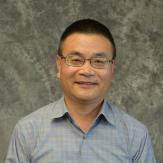Condensed Matter Experiment
Guang Bian’s research focuses on precise fabrication and spectroscopic characterization of low-dimensional quantum systems and novel electronic materials. I am also interested in physical properties of new functional materials including their growth mechanism, electronic and magnetic structure, surface and interfacial physics, and quantum size effects. The primary experimental techniques include angle-resolved photoemission spectroscopy (ARPES), scanning tunneling microscope (STM) and molecular beam epitaxy (MBE). Recently we have constructed an experimental platform in our lab, the Missouri Integrated Nano-Analysis System (MINAS). The MINAS system is equipped with APRES, MBE, and STM, which is fully capable of various sample growth and spectroscopic characterizations.
Suchi Guha’s research activity focuses on organic semiconductors. Her research involves optical spectroscopic techniques such as Raman scattering, photoluminescence/absorption, modulation spectroscopy including high-pressure techniques; fabrication and characterization of light-emitting displays, field effect transistors, and solar cells using organic polymers and molecules. She exploits light scattering techniques to answer key questions pertaining to the local structure of conjugated systems and in probing the nature of vibronic coupling as well as structural changes associated with transport in organic field-effect transistors (FETs) and other devices.
On-going research projects involve: (i) improving the performance of FETs by controlling the polymer-dielectric interface via modification of the dielectric layer and incorporating new growth techniques for the polymer layer; (ii) probing charge transfer complexes in bulk heterojunction organic solar cells; (3) the role of triplet excitations in charge transport and light-emission mechanisms; (4) high-pressure optical spectroscopy of donor-acceptor bulk organic heterojunctions.
X-ray and neutron scattering have played a critical role in developing the present understanding of condensed matter physics by revealing the way that matter organizes itself both spatially and dynamically. Countless contributions include understanding the behavior of crystals, alloys, glasses, fluids, phase transitions, magnetism, superconductivity, and ferroelectricity, to name just a few. With the development of highly intense radiation sources, these probes are beginning to investigate physics at the surfaces and interfaces of condensed matter.Paul Miceli’s current research program utilizes surface-sensitive scattering techniques to investigate two different areas: the physics of epitaxial crystal growth and superconductivity.
- A major component of Paul Miceli’s research on epitaxial crystal growth seeks to understand the fundamental mechanisms behind kinetic roughening where surface height fluctuations develop during the evaporation of material onto a surface. In addition to being an intellectually challenging problem in statistical physics, these are crucial issues for technological applications, which increasingly require the control of interface structure on an atomic scale.
- From synchrotron x-ray scattering experiments performed, in situ in ultra-high vacuum, his research has focused primarily on homoepitaxial growth systems where clear conclusions can be drawn. For example, the experiments conducted have established that when atomic diffusion over a crystalline surface-step-edge dominates the growth kinetics, the growth fits into a universality class that is robust with temperature and is characterized by simple scaling laws. Other areas of research include atomic relaxation at surfaces as well as studies of misfit dislocations where x-rays can uniquely observe surface morphology simultaneously with defects at buried interfaces.
- The second area of Paul Miceli’s research investigates the effect of surfaces on superconductivity using spin-polarized neutron reflectivity (SPNR) techniques. Recently, his group demonstrated the sensitivity of SPNR to vortices parallel to the surface in superconductors. This geometry is difficult to study by other techniques, yet it is a geometry where the surface effects are strongest. Subsequent experiments showed that the surface provides such a strong anisotropy in weak-pinning superconductors that the vortex magnetic field reorients perpendicular to the film plane when the applied magnetic field is reduced. Ongoing experiments in Miceli’s group are looking at surface-induced vortex ordering in multilayer superconductors.
The research program is implemented using a number of facilities. Th group has a rotating anode x-ray laboratory where high-resolution scattering and reflectivity measurements can be performed. In situ growth studies of homoepitaxy have been carried out in collaboration with P. W. Stephens on the SUNY X3 beamline at the National Synchrotron Light Source at Brookhaven National Laboratory. As members of the Midwest Collaborative Access Team (MUCAT), the group is also building new surface x-ray scattering facilities at the Advanced Photon Source located at Argonne National Laboratory. These will have unique and broad-ranging capabilities to study epitaxial crystal growth. The spin-polarized neutron reflectivity work is primarily carried out on campus at the Missouri University Research Reactor (MURR).
Wouter Montfrooij’s main research interest is the study of phase transitions in condensed matter. Of particular interest are phase transitions in which the ordered phase does not occur until zero Kelvin, the so-called quantum phase transitions. These transitions are different from ‘classical’ phase transitions in the sense that quantum fluctuations are more important than thermal fluctuations, resulting in a new type of ordering behavior. These transitions are primarily studied by means of neutron scattering experiments, and by susceptibility and transport measurements. Also, Montfrooij researches magnetic moments in liquid metals, the superfluid phase of liquid helium (a phase in which the fluid has zero viscosity), and the magnetic properties of spinel structures, such as magnetite (better known as lodestone).
Ping Yu’s current research is to develop molecular imaging techniques based on optical methods for study of biological systems. I am also interested in development of new materials and devices for terahertz generation and detection, and application to imaging biological systems. One of his recent projects is optical coherence imaging (OCI) on tumor tissue. OCI provides direct images without computed reconstructions, and is depth-gated, making it possible to fly through scattering tissue as a succession of optical sections. The work was reported in Physics Today (Physics Today, vol. 56, p.9, September 2003) and Science (Science, vol. 301, p.568, 1 August 2003).
Condensed Matter Experiment Faculty
Organic optoelectronics and optical spectroscopy of organic/inorganic semiconductors.
Crystal Growth, Optoelectronics Devices, Electron Microscopy, Electrochemistry…
Surfaces and interfaces of condensed matter investigated by X-ray and neutron scattering.
Hierarchical nanofabrication and single crystal synthesis of solid state materials.






